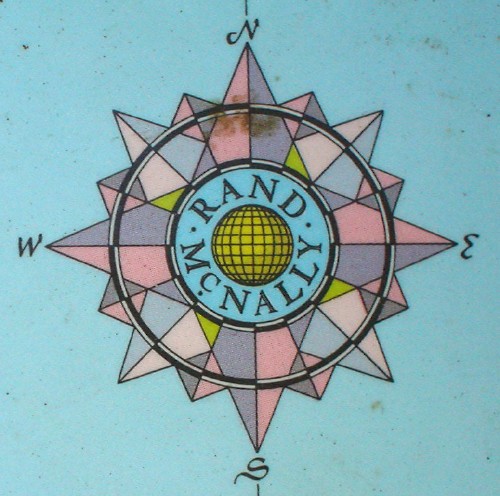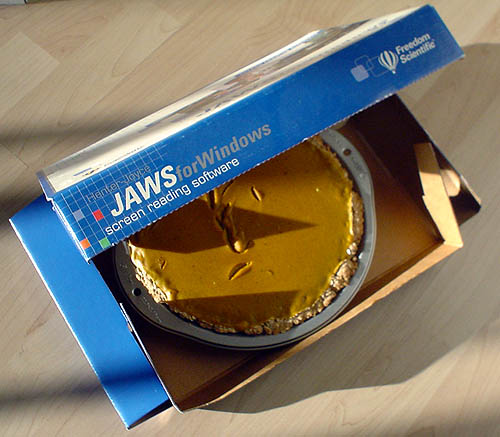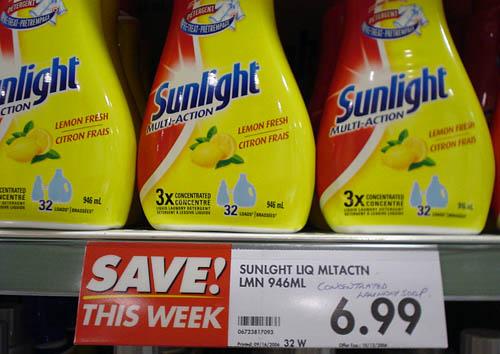The radically unsweet Tom’s of Maine toothpaste. It tastes solely like spearmint and feels solely like toothpaste.

The radically unsweet Tom’s of Maine toothpaste. It tastes solely like spearmint and feels solely like toothpaste.

The foregoing posting appeared on Joe Clark’s personal Weblog on 2006.10.18 18:05. This presentation was designed for printing and omits components that make sense only onscreen. The permanent link is: https://blog.fawny.org/2006/10/18/unsweet/
Sid Adilman, longtime entertainment columnist for the Toronto Star, died on Saturday at age 68. (Blog coverage; feature; obituary.)
I owe my entire professional writing career to him. While I had managed to squeak a couple of dozen articles into obscure publications in the late ’80s, it was Sid who gave me a break, allowing me to write a squibette about an AIDS documentary for him. The story ran on 1991.02.07. I would later write dozens of articles for the Star, and I actually wrote its first Internet (not Web) column. I would also write articles and columns for the Globe and Mail (and I was the first person to receive their freelance-writer contract, over which we won a partial but significant victory in the Supremes last week). I wrote for three dozen publications in total. I wrote a book, and have others in progress. And it all started in earnest with a story I wrote on company time and company equipment while working as an office lady at the Ministry of Sensitivity.
I talked with Sid on the phone at length about the article – despite its brevity, it was ruthlessly edited. But he changed almost nothing, because it was a strong piece. I see now that he liked it because it contained original reporting and miniscoops, two hallmarks of his. He gave me the highest compliment of my entire writing career, if not my entire life: “It reads well.”
We kept in very sporadic touch over the years. It was a supremely cold day in winter when I biked down to the bunker that is the Toronto Star building to sit in the studio commissary and explain to him what captioning is and why the plan he was floating to use captioning to subtitle English- and French-language programming wouldn’t work. It was an involved discussion. Very involved. But a couple of years later, Sid wrote a feature article about me and my efforts to improve cinema accessibility, very much without the help of the Little Shits™ who ran Famous Players at the time. That article ran on a full page of the entertainment section on 2002.06.15 and included photographs that made me look like a bleached-out Smurf.
The Star, whose feudal labour relations rival the CBC’s, turned the screws on Sid around retirement time. He simply walked out of the building one day and didn’t come back. Sid developed kidney disease that prevented us from talking much (I think we had two phone calls and a few E-mails). I have never had a single career at any given time, but the writing portion of my career would never have gotten off the ground, at all, without Sid.
And so the roster of my defenders shrinks by one.
The foregoing posting appeared on Joe Clark’s personal Weblog on 2006.10.16 14:59. This presentation was designed for printing and omits components that make sense only onscreen. The permanent link is: https://blog.fawny.org/2006/10/16/adilman/
All the features that seem obviously wrong in this photograph I actually like.

According to the location permit, the production is entitled Roxy Hunter. À la recherche de Bryan Ferry?
The foregoing posting appeared on Joe Clark’s personal Weblog on 2006.10.15 17:15. This presentation was designed for printing and omits components that make sense only onscreen. The permanent link is: https://blog.fawny.org/2006/10/15/roxyhunter/

The foregoing posting appeared on Joe Clark’s personal Weblog on 2006.10.15 17:09. This presentation was designed for printing and omits components that make sense only onscreen. The permanent link is: https://blog.fawny.org/2006/10/15/vietealvetica/



The foregoing posting appeared on Joe Clark’s personal Weblog on 2006.10.13 16:10. This presentation was designed for printing and omits components that make sense only onscreen. The permanent link is: https://blog.fawny.org/2006/10/13/rand-mcnally/
Jaws turns out to be useful for something after all.

The foregoing posting appeared on Joe Clark’s personal Weblog on 2006.10.09 14:16. This presentation was designed for printing and omits components that make sense only onscreen. The permanent link is: https://blog.fawny.org/2006/10/09/pumpkin-jaws/
When, right below a display of the product in its blazing primary colours, your staff still has to handwrite a description.

Which do you understand better, Concentrated laundry soap or SUNLGHT LIQ MLTACTN LMN 946ML?
The foregoing posting appeared on Joe Clark’s personal Weblog on 2006.10.08 17:13. This presentation was designed for printing and omits components that make sense only onscreen. The permanent link is: https://blog.fawny.org/2006/10/08/multi-action/

The foregoing posting appeared on Joe Clark’s personal Weblog on 2006.10.07 14:01. This presentation was designed for printing and omits components that make sense only onscreen. The permanent link is: https://blog.fawny.org/2006/10/07/tuyaux-jaunes/
Our dear friends at the CRTC issued a call for comments on a review of over-the-air broadcasting policy. (Did you understand that?) Apropos of nothing, the CRTC jammed in a few questions about captioning. After spending nearly 30 years doing everything in its power to deny viewers with disabilities full accessibility to the television system, suddenly the CRTC was proposing a 100%-captioning requirement – but all complaints would be outsourced to an industry group. How crazy is that?
Of course I submitted my own withering comments. To test the CRTC’s ability to handle standards-compliant documents, I submitted a file (not a Web page on a server) written in validated, well-formed XHTML 1.1 with correct MIME type and file extension. (It is perhaps one of the only such files in existence.) And what was the first thing I heard back? “We can not open your document.” I was then invited to resubmit in Word or PDF. I don’t think so. Maybe next time I’ll file a Braille printout.
The CRTC has nearly the worst Web site on the planet, and it is impossible to link to any submissions filed, all of which appear to be saved as Word, PDF, or indeed simple TIFF documents. Love that accessibility. CBC’s response, entitled “A New Framework for Canadian Television,” was submitted in tagged PDF, oddly enough, and contains all the bullshit we’ve come to expect.
CBC Television captions 100% of its overall programming
No, it does not, as I have proven and the CBC has not disputed.
CBC Television and Télévision de Radio-Canada recognise the vital importance of captioning their programs. They have made, and continue to make investments in new technologies and training to improve captioning to ensure that captions are of the highest quality.
And what training would that be? (Peggy Zulauf sits you down and tells you what she thinks?)
It must be acknowledged, however, that some circumstances still make it impossible to attain the ideal.
Like the following intentional and deliberate corporate policies?
The Standing Committee on Cultural Heritage report, Our Cultural Sovereignty, published in June 2003 (“Lincoln Report”) identified these differences:
I identified them for the committee. They wouldn’t be in the report if I hadn’t provided “evidence” to that committee in 2002.
- Difficulty with French captioning lies in the technology used, which is based on an English-language model. In the case of real-time captioning, the hardware must be remapped with French phonology to accommodate accents and other characteristics of the French language not present in the English language. Gender and number agreement also present problems.
- Given that French generally contains more words per sentence than English, it is sometimes difficult for captioners to keep pace with the action onscreen in the case of real-time captioning.
Straight from the horse’s mouth.
However, there is no consensus between broadcasters and the hearing-impaired community as to a universally acceptable error rate or even what constitutes an error. In order to establish an “industry standard” it would be necessary to:
- Develop a consensus on how errors should be calculated. For example, should it be the ratio of errors made in relation to total words spoken during a program, or in relation to the total number of closed-captioned words?
- Assess the level of captioning performance by broadcasters across the system using those definitions.
- Recognise [sic] that error rates cannot be the same for all types of programs, e.g., acceptable error rates would need to be higher for programs captioned in real-time, especially for those captioned in real-time French.
These steps would represent a considerable undertaking for both the Commission and the broadcasting industry.
I have a research project to do just that.
The industry has also made progress in improving the quality of captioning
False even from a cursory examination, and there aren’t any well-researched and tested standards to go by.
CBC/Radio-Canada handles complaints related to the quality and quantity of captioning internally and considers this to be the most effective way to manage this issue. We respond in a timely manner to complaints and use that process to help reduce or eliminate captioning problems.
What “CBC/Radio-Canada” actually does is ignore and belittle complainants, refuse to meet them, and attempt to derail the whole process.
Mandating a third party to essentially “regulate” the industry with respect to captioning is unnecessary and premature given that there are no effective measures of captioning quality and no consensus view on an appropriate standard error rate.
That’s because my research project hasn’t written the standards or developed a “consensus view.”
And isn’t it terribly interesting that the CBC submission never once mentions that it essentially lost a human-rights complaint and has to caption 100% of CBC Television and Newsworld programming? Isn’t that a rather germane point when discussing the topic of 100% captioning? Is it also a germane point that Radio-Canada had to settle a separate complaint?
The foregoing posting appeared on Joe Clark’s personal Weblog on 2006.10.06 12:50. This presentation was designed for printing and omits components that make sense only onscreen. The permanent link is: https://blog.fawny.org/2006/10/06/cbc-ota/